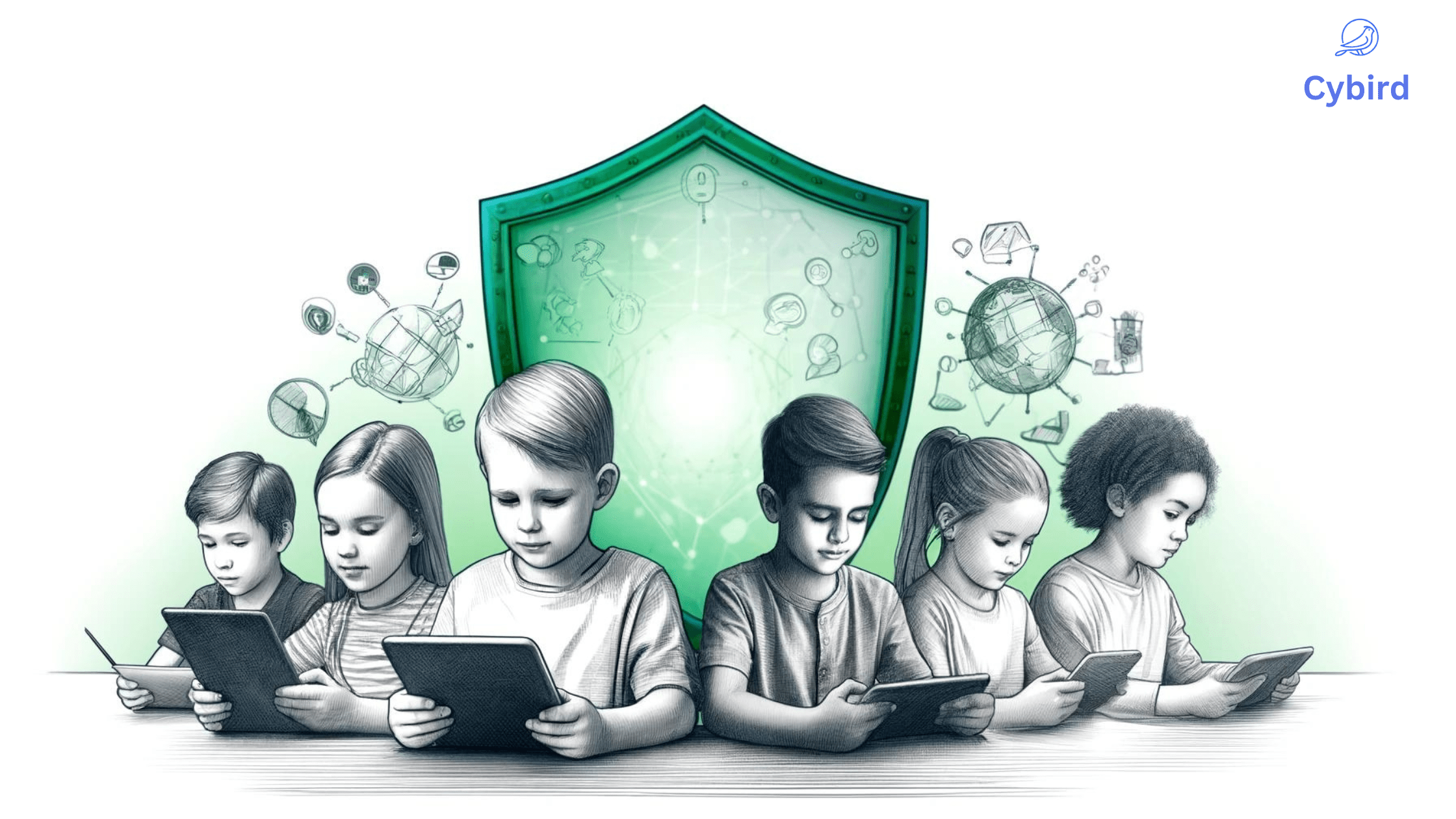Key stats to start with –
- Approximately 53% of children in the United States have their own smartphone by the age of 11. This trend reflects a significant digital engagement among young users, with many starting to use these devices even earlier during their childhood (KQED).
- Among teenagers, 84% own their own phones, engaging deeply with a diverse array of digital experiences.
Introduction
In Silicon Valley, where technology innovates at every turn, many top executives are choosing to postpone smartphone access for their children until they’re at least 14. This decision stems from numerous concerns that every parent should consider. Let’s delve into these issues and how Cybird provides a safer digital environment for children.
Smartphones Are Changing Childhood
The classic image of childhood—outdoor play, family time, and reading—is now often replaced by hours on Snapchat, Instagram, and YouTube. Children typically spend 3 to 7 hours daily in front of screens, pushing aside essential developmental activities for online entertainment.
The Addictive Nature of Smartphones
Research indicates that smartphones can induce brain responses similar to addictive substances such as alcohol and drugs. Designed to keep users engaged for long periods, these devices can foster significant dependency, comparable to gambling.
Academic Distractions and Impairments
The formative years of a child’s education are crucial. Smartphones act as a constant distraction, potentially leading to academic struggles. Studies reveal that even the mere presence of a smartphone can diminish cognitive capacity and impair test performance.
Adverse Effects on Brain Development
Pioneering research by the National Institute of Health shows that extensive screen time can cause premature thinning of the cortex, the part of the brain that processes sensory information.
Impact on Sleep and Health
Excessive screen time disrupts sleep patterns, leading to poorer sleep quality and shorter sleep duration, which can affect overall health, growth, and mental wellness.
Behavioral and Emotional Risks
Increased screen time is associated with a higher risk of behavioral disorders such as conduct disorder and oppositional defiant disorder. Extensive social media use is also linked with increased anxiety, depression, and even eating disorders among young users.
Interference with Relationships
Smartphones can disrupt nurturing face-to-face relationships, replacing meaningful family interactions with superficial online connections.
Exposure to Inappropriate Content and Cyberbullying
Smartphones heighten the risk of exposure to sexual content and cyberbullying, with many children experiencing or engaging in online harassment.
Digital Harmony at Home: Practical Steps for Parental Control and Family Digital Detox
- Setting Up Parental Controls:
- Choose a Control App: Install a parental control app like Cybird, Qustodio or FamilyTime on your child’s device.
- Customize Settings: Set specific filters for web browsing, app usage, and screen time limits. Tailor these settings based on your child’s age and maturity.
- Monitor and Adjust: Regularly review the app’s activity reports and adjust the controls as necessary to ensure they remain effective as your child grows.
- Choose a Control App: Install a parental control app like Cybird, Qustodio or FamilyTime on your child’s device.
- Initiating a Digital Detox for the Family:
- Plan Together: Discuss the importance of a digital detox with your family and agree on a reasonable duration to start, such as a weekend or during a vacation.
- Define Rules: Establish clear rules for what is and isn’t allowed during the detox period. For example, no smartphones at the dinner table, or no TV after 8 PM.
- Engage in Offline Activities: Plan activities that can replace screen time, such as board games, outdoor activities, or book reading.
- Evaluate and Reflect: After the detox, discuss as a family the challenges faced and the benefits enjoyed. Decide if you want to incorporate some of these changes into your daily routine.
- Plan Together: Discuss the importance of a digital detox with your family and agree on a reasonable duration to start, such as a weekend or during a vacation.
Parental Involvement
Effective parental involvement in managing children’s device use is crucial. Strategies can include co-viewing, which allows parents to watch content with their children, fostering discussions about what they see online. Setting clear rules about screen time, such as specific no-device times during family meals or before bedtime, helps establish boundaries. It’s also beneficial for parents to be actively involved in selecting apps and websites their children use, ensuring they are age-appropriate and educational.
Educational Balance
Balancing educational content with entertainment on digital devices is key to productive screen time. Parents should prioritize and encourage the use of educational apps and platforms that enhance learning. For younger children, interactive reading apps or math games can be particularly beneficial. For older children, platforms that offer courses on a variety of subjects or creative skills can be engaging. It’s essential to choose content that not only educates but also captures children’s interest, making learning enjoyable rather than a chore.
My Family’s Approach to Technology
Navigating the digital world as a parent has its challenges, but also its rewards. Here’s a glimpse into how we’ve managed technology in our household:
- Laptop Introduction: When COVID-19 transformed how we live and learn, we provided our daughter with her first laptop in 8th grade. This wasn’t just a portal to her education; it became her window to maintaining social interactions during lockdowns.
- Smartphone Ownership: Only in 10th grade did we feel it was appropriate for our daughter to have her own smartphone. Until then, all her communications with friends were through my or my wife’s phone. This helped us monitor her interactions and ensure she was ready for the responsibility that comes with a personal device.
- Coding Skills: Despite my expertise in coding, I chose not to teach my daughter this skill. The decision was guided by the desire to let her find her own interests and passions, rather than prescribing them.
These experiences have shaped not only our daughter’s digital competence but also our family’s approach to technology, blending guidance with independence.
Cybird: A Comprehensive Solution for Family Safety
Understanding the risks associated with early smartphone use, Cybird offers a robust solution tailored for family safety:
- Comprehensive Controls: Manage and monitor children’s screen time to ensure safe and appropriate content engagement.
- Up-to-Date Protections: Cybird’s cloud-first approach keeps it always current, providing real-time protection against online threats without the need for frequent updates.
- Educational Tools: Promote productive use of technology with features that support educational and developmental activities.
- Customizable Restrictions: Block adult content, filter major search engines like Google and YouTube, and restrict access to addictive apps like TikTok.
- Scheduled Limitations: Set specific times for study and bedtime to minimize distractions and promote healthier routines.
- Universal Coverage: Protect your children both at home and on the go, ensuring their digital environment is always secure.
Conclusion
Technology offers vast learning and connectivity opportunities, but it’s crucial to introduce it responsibly. By delaying smartphone use and employing protective tools like Cybird, parents can safeguard their children’s development and well-being, fostering a balanced and secure digital landscape.
Additional Resources:



Founder & CEO of Cybird. Cybersecurity expert for families.
